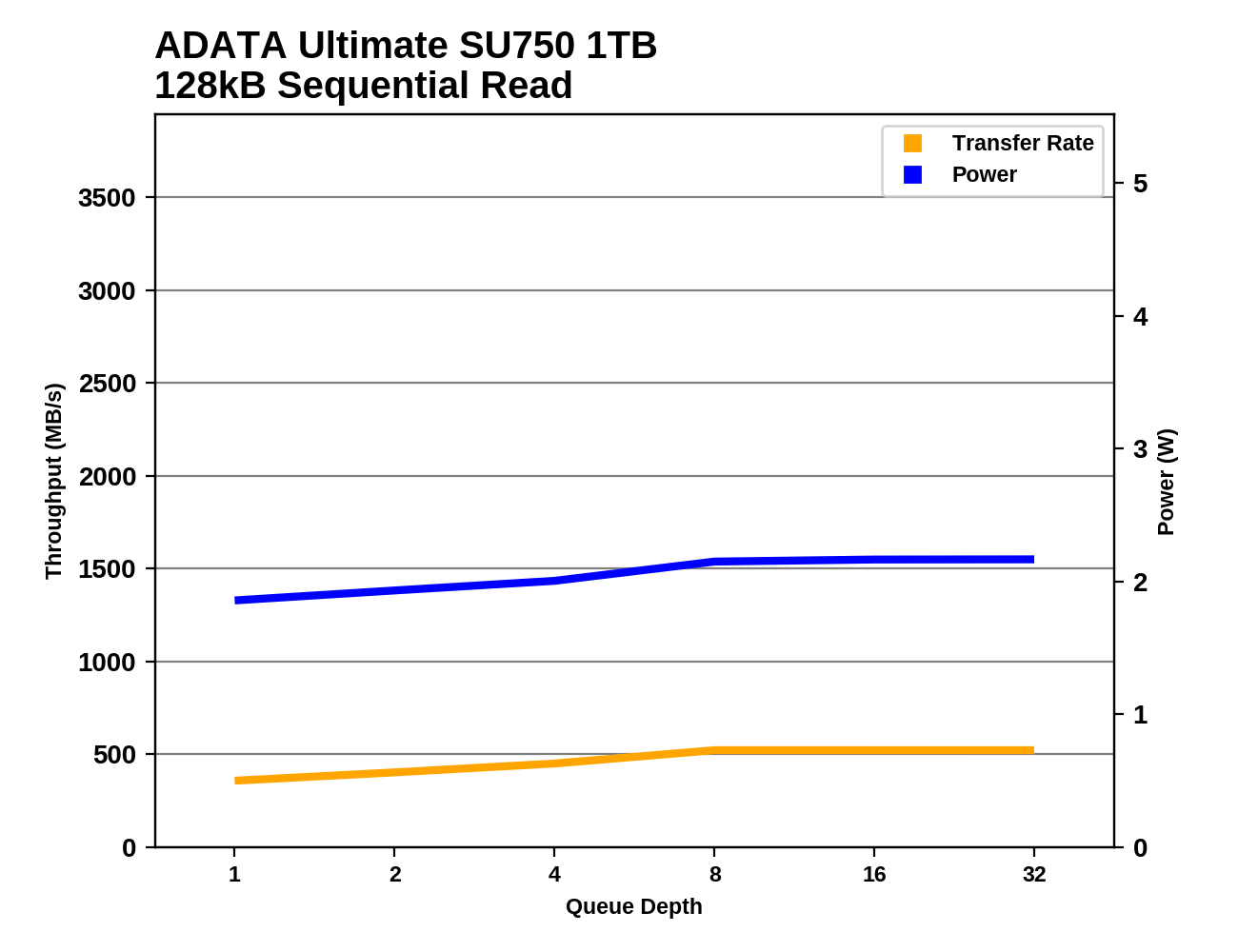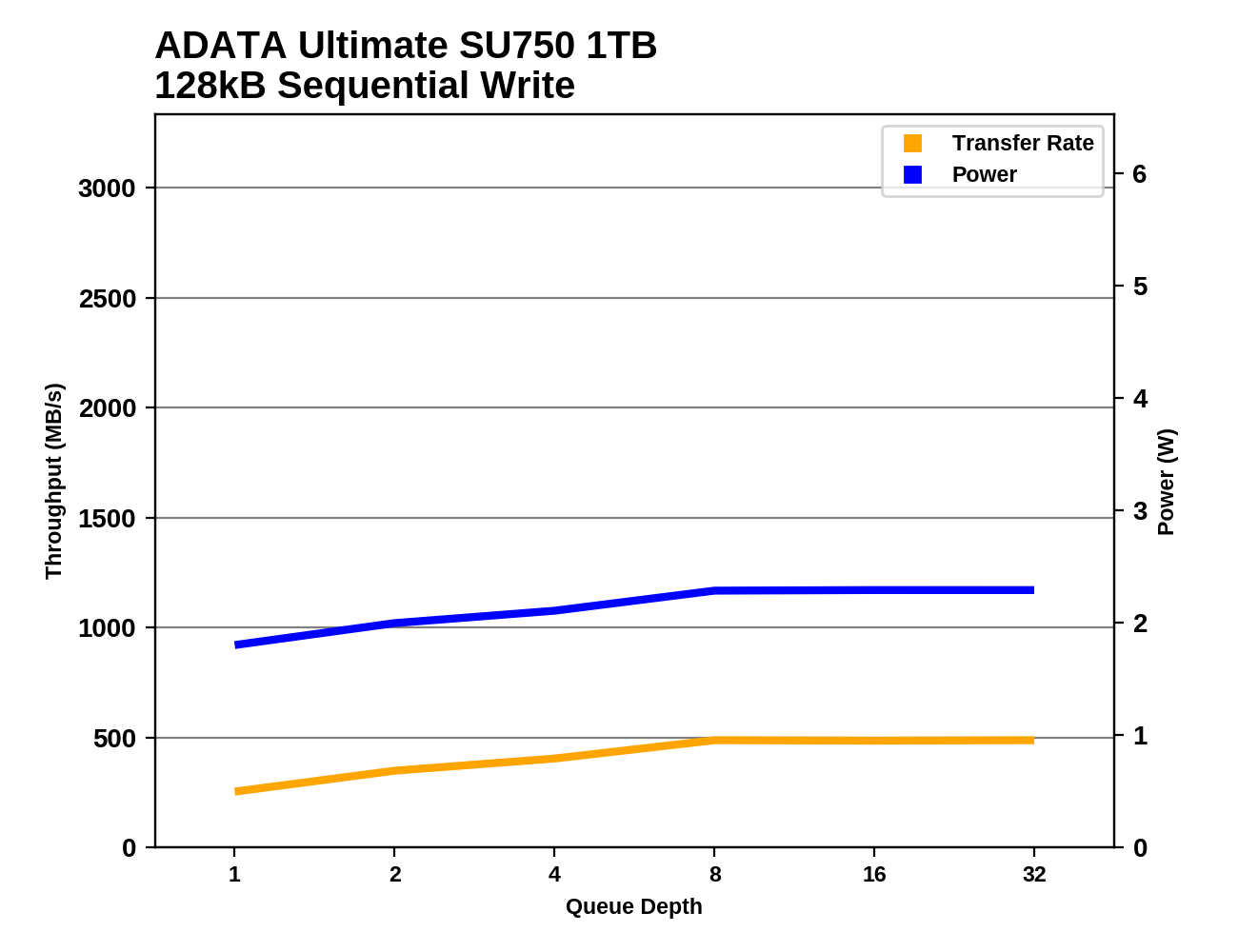The ADATA Ultimate SU750 1TB SSD Review: Realtek Does Storage, Part 1
by Billy Tallis on December 6, 2019 8:00 AM ESTSequential Read Performance
Our first test of sequential read performance uses short bursts of 128MB, issued as 128kB operations with no queuing. The test averages performance across eight bursts for a total of 1GB of data transferred from a drive containing 16GB of data. Between each burst the drive is given enough idle time to keep the overall duty cycle at 20%.

The burst sequential read performance from the ADATA Ultimate SU750 is a little bit slower than the mainstream SATA drives, but it's ahead of the other two entry-level drives.
Our test of sustained sequential reads uses queue depths from 1 to 32, with the performance and power scores computed as the average of QD1, QD2 and QD4. Each queue depth is tested for up to one minute or 32GB transferred, from a drive containing 64GB of data. This test is run twice: once with the drive prepared by sequentially writing the test data, and again after the random write test has mixed things up, causing fragmentation inside the SSD that isn't visible to the OS. These two scores represent the two extremes of how the drive would perform under real-world usage, where wear leveling and modifications to some existing data will create some internal fragmentation that degrades performance, but usually not to the extent shown here.

On the longer sequential read test, the SU750 is in last place and about 15% slower than the 860 QVO, though when reading back data that was written out of order, the 860 QVO is worse. The DRAMless Toshiba TR200 does well in both cases.
 |
|||||||||
| Power Efficiency in MB/s/W | Average Power in W | ||||||||
The power efficiency scores from the SU750 are again among the lowest, but unlike the random IO tests it isn't a big outlier in terms of either efficiency or total power draw.
 |
|||||||||
The SU750 does eventually reach sequential read speeds that more or less saturate the SATA link, but it requires a higher queue depth than any of the other drives in this batch. Power consumption is consistently just a bit higher than typical for mainstream drives, so at high queue depths its efficiency scores wouldn't be as bad as the low-QD scores shown above.
The SU750's sequential read speed at QD1 is definitely one of the slowest results we've seen, but at higher queue depths it is adequately fast and its power consumption is merely above-average and doesn't stand out from the crowd.
Sequential Write Performance
Our test of sequential write burst performance is structured identically to the sequential read burst performance test save for the direction of the data transfer. Each burst writes 128MB as 128kB operations issued at QD1, for a total of 1GB of data written to a drive containing 16GB of data.

The burst sequential write performance of the SU750 is clearly slower than mainstream SATA drives, but is nowhere near as bad as the Toshiba TR200's sub-HDD result.
Our test of sustained sequential writes is structured identically to our sustained sequential read test, save for the direction of the data transfers. Queue depths range from 1 to 32 and each queue depth is tested for up to one minute or 32GB, followed by up to one minute of idle time for the drive to cool off and perform garbage collection. The test is confined to a 64GB span of the drive.

On the longer sequential write test that brings in some higher queue depths, the SU750 falls a little further behind the mainstream SATA drives, and the Samsung 860 QVO crashes down to last place while the Toshiba TR200 starts to catch up with the SU750.
 |
|||||||||
| Power Efficiency in MB/s/W | Average Power in W | ||||||||
The power efficiency score for the SU750 during the sequential write test is not bad, for a change. The absolute power consumption is lower than most of the other drives, and the performance is good enough to make for decent efficiency.
 |
|||||||||
As with the sequential read test, the SU750 needs a fairly high queue depth to reach its full sequential write performance, which is competitive with mainstream SATA drives. It retains that performance for the rest of the test.
The low-QD sequential write performance from the SU750 could certainly be a lot worse, judging by some of the results from our archive. Across its entire speed range, the power consumption of the SU750 seems to be a bit below average, but never low enough to translate into impressive efficiency.












54 Comments
View All Comments
romrunning - Friday, December 6, 2019 - link
This whole suite of tests reminds me of how terrible QLC is for performance, whether in the woeful Intel 660p or this ADATA SU750. YMMV, but I'm okay with never buying one.Also, I can remember back in the days when I first saw Realtek pop up in networking. There were usually issues, and then you had to replace them with a 3Com NIC. But "cheap" is king, and guess who is still around. Now you know what your parents felt like when they reminisce about the "good old days".
extide - Friday, December 6, 2019 - link
This drive does not use QLC.romrunning - Friday, December 6, 2019 - link
Sorry - true, it doesn't use QLC; the SU750 is just DRAM-less.PeachNCream - Friday, December 6, 2019 - link
ADATA can make SSD performance suck even without QLC and price it as if it is a competitive product. That's sort of an accomplishment in its own way.brucethemoose - Friday, December 6, 2019 - link
I wonder how low they could go with QLC instead of TLC. Maybe the extra work required to get QLC even functioning on this Realtek controller would negate any savings.name99 - Friday, December 6, 2019 - link
Remember not everyone NEEDS every aspect of performance!I would prefer to have my audio-visual library on SSD so that searching is faster (waiting a few seconds for drive spin-up is always irritating) but no aspect of QLC (eg reduced total write volume, or slow writes) is problematic for that use case...
PeachNCream - Friday, December 6, 2019 - link
Agreed, but if the SSD in question is slower than a different SSD with similar endurance and capacity that is priced the same, why get less for your money just because your p0rn collection doesn't need low latency responsiveness?Samus - Saturday, December 7, 2019 - link
The thing is, the 660p and now 665p are great drives for average users. You get rock bottom price (though the drives mysteriously spiked up by 30% recently) and a decently reliable drive that delivers good burst transfer rates. Write performance is fine, still faster than a SATA drive until the pSLC is cached.rrinker - Friday, December 6, 2019 - link
Would really like to see some "low end" 2 or eve 4TB SSDs. Even a low end SSD is faster than a spinny disk, and I'd love to build my whole server with SSD - a pair of higher end ones for a fast cache, with a bunch of low end ones for the mass storage.FunBunny2 - Friday, December 6, 2019 - link
"Even a low end SSD is faster than a spinny disk"true, but HDD that get past infant suicide can last a very long time.